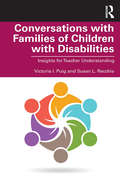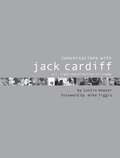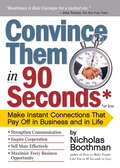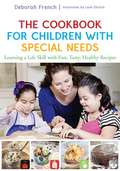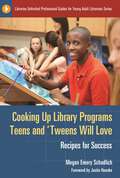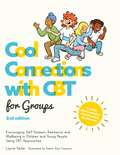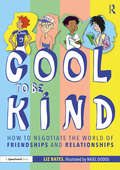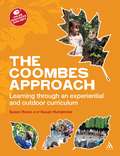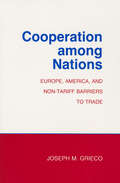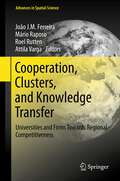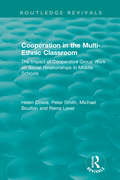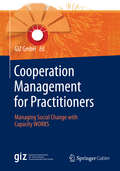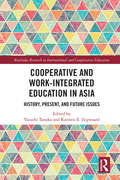- Table View
- List View
Conversations with Families of Children with Disabilities: Insights for Teacher Understanding
by Victoria I. Puig Susan L. RecchiaConversations with Families of Children with Disabilities creates a space for diverse families of children with disabilities to share their stories with pre-service and in-service teachers. Specifically designed for professionals preparing to work with families of children with disabilities, this text invites the reader to listen in as families reflect on their personal journeys in conversation with the authors. This powerful book helps educators develop a deeper understanding of families and enhance their capacity for authentic partnerships.
Conversations with Families of Children with Disabilities: Insights for Teacher Understanding
by Victoria I. Puig Susan L. RecchiaConversations with Families of Children with Disabilities creates a space for diverse families of children with disabilities to share their stories with pre-service and in-service teachers. Specifically designed for professionals preparing to work with families of children with disabilities, this text invites the reader to listen in as families reflect on their personal journeys in conversation with the authors. This powerful book helps educators develop a deeper understanding of families and enhance their capacity for authentic partnerships.
Conversations With Form: A Workbook for Students of Architecture
by N. John Habraken Andrés Mignucci Jonathan TeicherThrough a progressive series of exercises - accompanied by observational studies, examples and applied theory - Conversations with Form: A Workbook for Students of Architecture improves designers’ understanding, dexterity and resilience in making form. It specifically focuses on the skills needed to succeed in the everyday context in which the vast majority of architects will ultimately design and build, wherein no one designs in isolation and existing conditions never represent a tabula rasa. The text begins by familiarizing readers with utilizing step-by-step sequences of moves to steer the development of built form and rapidly moves to designs of increasing complexity. These design plays treat a wide-ranging series of topics including structures, patterns, types, systems and other kinds of shared form principles. Conversations with Form is a workbook for honing hands-on skills and tools of the architect’s trade. Beautifully illustrated and focused on practical, usable information, the book provides architectural students with an accessible and useable handbook for their design practice.
Conversations With Form: A Workbook for Students of Architecture
by N. John Habraken Andrés Mignucci Jonathan TeicherThrough a progressive series of exercises - accompanied by observational studies, examples and applied theory - Conversations with Form: A Workbook for Students of Architecture improves designers’ understanding, dexterity and resilience in making form. It specifically focuses on the skills needed to succeed in the everyday context in which the vast majority of architects will ultimately design and build, wherein no one designs in isolation and existing conditions never represent a tabula rasa. The text begins by familiarizing readers with utilizing step-by-step sequences of moves to steer the development of built form and rapidly moves to designs of increasing complexity. These design plays treat a wide-ranging series of topics including structures, patterns, types, systems and other kinds of shared form principles. Conversations with Form is a workbook for honing hands-on skills and tools of the architect’s trade. Beautifully illustrated and focused on practical, usable information, the book provides architectural students with an accessible and useable handbook for their design practice.
Conversion at Corinth: Perspectives on Conversion in Paul's Theology and the Corinthian Church (Studies of the New Testament and Its World)
by Stephen J. ChesterPaul's conversion and its impact on his theology has been studied extensively. Yet little has been done to relate this to Paul's attitude towards the conversion of others, or to perspectives on conversion held by converts in the churches Paul founded. Soteriology is often considered in isolation from the practical issues of how conversion was expected to take place and the nature of its expected consequences. This book addresses these issues, taking account of recent developments in conversion studies in the social sciences and other disciplines. Stephen Chester first reviews these developments and assesses the potential value of sociologist Anthony Gidden's general social theory of structuration. He then utilizes this to explore Paul's perspectives on conversion in relation to both Gentile and Jewish converts. He also explores the Corinthians' perspectives on conversion in the context of Graeco-Roman religious and social life. Here emerges a fascinating account of perspectives on conversion in the crucial formative years of early Christianity.
Conversion in Luke and Paul: Conversion In Luke And Paul: An Exegetical And Theological Exploration (The Library of New Testament Studies #464)
by David S. MorlanThis study explores the conversion theologies of Luke and Paul. For Luke and Paul conversion played an important role in the early Christian experience and Morlan offers a fresh look into how they interpreted this phenomenon. Morlan traverses representative texts in the Lukan and Pauline corpus equipped with three theological questions. What is the change involved in this conversion? Why is conversion necessary? Who is responsible for conversion? Morlan presents theological and exegetical analysis of Luke 15, Acts 2, Acts 17.16-34, Romans 2 and Romans 9-11 and answers these questions, and, in turn, builds theological profiles for both Luke and Paul. These profiles provide fresh insight into the theological relationship between Luke and Paul, showing significant similarities as well as sharp contrasts between them. Similarities surface between Luke and Paul concerning the centrality of Christology in their conversion theologies. While showing a complex relationship between human and divine agency in conversion, both Luke and Paul understand successful conversion to be impossible without the intervention of an agency outside of the pre-convert.
The Conversion of the Nations in Revelation (The Library of New Testament Studies #438)
by Allan J. McNicolAllan McNicol examines the 'Conversion of the Nations' in the book of Revelation together with the author's vision for final redemption. Allan McNicol examines the longstanding tension between the author of Revelation 's description of the destruction of unrepentant nations early in the book in contrast with their final experience of salvation in Rev 21.24-26. McNicol examines how the author of Revelation interprets and refashions both scripture and the myths of the age in order to lay out his vision of redemption - leading to his ultimate conclusion that human political power (Rome) will crumble before the influence of the crucified Jesus. Through careful attention to references to the 'pilgrimage to the Gentiles' in prophetic literature, McNicol is able to draw valuable conclusions as to how the core tension examined may be resolved. This exegesis is in turn able show how the author of Revelation's alternative voice to Rome's power emerged among a small minority community in the Eastern Roman Empire and gained plausibility. This voice not only could articulate a construct of its own vindication (thus empowering its own converts) but it also construed a new destiny for the nations themselves separate and apart from Rome.
Converting STEM into STEAM Programs: Methods and Examples from and for Education (Environmental Discourses in Science Education #5)
by Michael P. Mueller Deborah J. Tippins Arthur J. StewartThis book examines the push and pull of factors contributing to and constraining conversion of STEM (science, technology, engineering and math) education programs into STEAM (science, technology, engineering, math and arts) education programs. The chapters in this book offer thought-provoking examples, theory, and suggestions about the advantages, methods and challenges involved in making STEM to STEAM conversions, at levels ranging from K12 through graduate university programs. A large driving force for STEM-to-STEAM conversions is the emerging awareness that the scientific workforce finds itself less than ideally prepared when engaging with so-called ‘wicked problems’ – the complex suite of emerging, multifaceted issues such as global climate change, social injustice, and pandemic diseases. Dealing with these issues requires cross-disciplinary expertise and the ability to insert technical and scientific understanding effectively into areas of public planning and policy. The different models and possibilities for STEAM, as the next phase of the STEM revolution, laid out in this book will promote research and further our understanding of STEAM as a forward-thinking approach to education.Gillian Roehrig, STEM Education, University of Minnesota, USAThe ideal teacher sees opportunities for integrating ideas from multiple disciplines into every lesson. This book offers many worthwhile suggestions on how to do that deliberately and systematicallyGeorge DeBoer, Project 2061 of the American Association for the Advancement of Science, USAFor the last several years, calls for expanding STEM education have grown, but so too have concerns about technocratic approaches to STEM. This volume challenges the community to consider broader views on STEM by focusing on the place of arts education within this movement. The chapters offer much needed, new perspectives on the (re)integration of the arts and sciencesTroy Sadler, School of Education, University of North Carolina, USA
Convince Them in 90 Seconds or Less: Make Instant Connections That Pay Off in Business and in Life
by Nicholas BoothmanNow in paperback, revised throughout, with a timely new chapter and title—The original How to Connect in Business in 90 Seconds or Less received praise such as: "Nick Boothman's brilliant stroke is to guarantee that within the first 90 seconds of meeting someone you'll be communicating like old trusted friends. But he doesn’t stop there. This book shows how to turn those instant connections into long-lasting, productive business relationships."—Marty Edelston, publisher, BottomLine/Personal. And: "Success in business depends on effectively communicating ideas, at least as much as thinking them up, and Boothman tells us how to do that."—Matthew Bishop, The Economist. Boothman's message is central, and in this current business climate, critical: whether selling, interviewing, or motivating a team, success depends on convincing the other person—and the quickest and best way to do that is through what he calls "rapport by design." Using the science of Neuro-Linguistic Programming (built upon body language, attitude, voice, and synchronizing behavior), Boothman shows how to create a winning first impression and, within 90 seconds, a lasting trust. Then, when those 90 seconds are up, he shows how to master the people-to-people skills that are essential to an ongoing business relationship. A new chapter added just for the paperback serves as a communication primer—drawing on his years in advertising, Boothman reveals how to make your message stand out and stick in a world that's already glutted with information.
The Cookbook for Children with Special Needs: Learning a Life Skill with Fun, Tasty, Healthy Recipes (PDF)
by Deborah French Leah EhrlichLearning to cook not only equips children with a valuable life skill, but will help boost self-esteem in other areas of their lives. The book starts with a basic illustrated guide to where food comes from, the different food groups, how to create our own diet and why cooking is a great skill to master. Simple, step-by-step instructions accompanied by fun illustrations, guide children through three levels of cooking, starting with fundamental basics including the preparation of a wide variety of different foods, and building up to more complex recipes. Health and safety skills are taught as an essential part of the cooking activity and healthy eating habits are reinforced throughout. Parents and carers will find cooking with children with special needs to be enjoyable and rewarding with this book, which thoroughly prepares the child for the cooking experience. Teachers, activity organisers and anyone else working with children with special needs will also find this book to be a great resource for cooking inspiration.
Cooking Up Library Programs Teens and 'Tweens Will Love: Recipes for Success (Libraries Unlimited Professional Guides for Young Adult Librarians Series)
by Megan Emery SchadlichEngage teens and 'tweens with library programs that nurture developmental and social needs—and keep young patrons entertained.Want to get students tuned in, learning, and having fun? Covering programs ranging from DIY Modern Crafts to CSI Science, these simple plans will give you all the knowledge you need to create complete programs for 'tweens and teens—activities that students will find engaging and entertaining.For each activity, the author identifies aspects that link to STEAM learning objectives. The educational ties help students learn about new topics while fostering the development of important life skills. While the plans are geared towards public librarians, they can easily be adapted to the school or home environment so parents, teachers, and anyone else who works with teens and 'tweens can create and implement these fun and unique programs.
Cooking Up Library Programs Teens and 'Tweens Will Love: Recipes for Success (Libraries Unlimited Professional Guides for Young Adult Librarians Series)
by Megan Emery SchadlichEngage teens and 'tweens with library programs that nurture developmental and social needs—and keep young patrons entertained.Want to get students tuned in, learning, and having fun? Covering programs ranging from DIY Modern Crafts to CSI Science, these simple plans will give you all the knowledge you need to create complete programs for 'tweens and teens—activities that students will find engaging and entertaining.For each activity, the author identifies aspects that link to STEAM learning objectives. The educational ties help students learn about new topics while fostering the development of important life skills. While the plans are geared towards public librarians, they can easily be adapted to the school or home environment so parents, teachers, and anyone else who works with teens and 'tweens can create and implement these fun and unique programs.
Cool Connections with CBT for Groups, 2nd edition: Encouraging Self-Esteem, Resilience and Wellbeing in Children and Teens Using CBT Approaches (Cool Connections with CBT)
by Laurie SeilerCool Connections is an early intervention programme for young people aged 9-14, focusing on preventing anxiety and depression. Through using CBT principles, skills adapted from behavioural activation, acceptance and commitment therapy and compassion-based therapies and therapeutic exercises, it encourages the development of resilience, self-esteem and wellbeing, to reduce feelings of anxiety and depression.This new and updated edition gives professionals working with groups everything they need to improve the wellbeing of children. With photocopiable and downloadable illustrated worksheets, it is clearly structured and straightforward to put into practice, and contains new sessions on self-regulation, identifying support networks and mindfulness.
Cool Connections with Cognitive Behavioural Therapy: Encouraging Self-esteem, Resilience and Well-being in Children and Young People Using CBT Approaches (PDF)
by Laurie SeilerCool Connections is a fun, engaging workbook that provides a cognitive behavioural therapy (CBT) approach to positively modifying the everyday thoughts and behaviours of children and young people aged 9 to 14. Combining a summary of CBT principles and step-by-step guidelines on how to use the materials appropriately with a mixture of games, handouts, home activities and therapeutic exercises, Cool Connections is designed to encourage resilience and self-esteem and reduce feelings of anxiety and depression. Fully photocopiable, fully illustrated and easy to use, this structured workbook is an effective tool for professionals working to improve the general wellbeing of children and young people, including psychologists, psychiatrists, counsellors, social workers, and child and adolescent mental health services, as well as professionals in residential care settings and educational professionals in child/youth services.
Cool to be Kind: How to Negotiate the World of Friendships and Relationships
by Liz BatesFor effective use, this book should be purchased alongside the professional guidebook. Both books can be purchased together as a set, Negotiating the World of Friendships and Relationships: A ‘Cool to be Kind’ Storybook and Practical Resource [9780367537807] This illustrated storybook introduces Coco, Otto, Ollie and Ling as they negotiate the sometimes tricky world of friendships and relationships, observing the unkindness of some and using their superpower – kindness – to change the lives of others. Explore with them what it means to be unkind, why that choice is sometimes made and how usually there is another choice – to be kind. This storybook will: Help facilitate discussions with children about values, morals and empathy Support children to see that kindness can be a cool choice to make Help you to introduce children to the notion that kindness and unkindness are choices This storybook is available to purchase as part of a two-component set, Negotiating the World of Friendships and Relationships: A ‘Cool to be Kind’ Storybook and Practical Resource. It can be used by teachers and support staff to teach and promote kindness to children at primary age and beyond.
Cool to be Kind: How to Negotiate the World of Friendships and Relationships
by Liz BatesFor effective use, this book should be purchased alongside the professional guidebook. Both books can be purchased together as a set, Negotiating the World of Friendships and Relationships: A ‘Cool to be Kind’ Storybook and Practical Resource [9780367537807] This illustrated storybook introduces Coco, Otto, Ollie and Ling as they negotiate the sometimes tricky world of friendships and relationships, observing the unkindness of some and using their superpower – kindness – to change the lives of others. Explore with them what it means to be unkind, why that choice is sometimes made and how usually there is another choice – to be kind. This storybook will: Help facilitate discussions with children about values, morals and empathy Support children to see that kindness can be a cool choice to make Help you to introduce children to the notion that kindness and unkindness are choices This storybook is available to purchase as part of a two-component set, Negotiating the World of Friendships and Relationships: A ‘Cool to be Kind’ Storybook and Practical Resource. It can be used by teachers and support staff to teach and promote kindness to children at primary age and beyond.
The Coombes Approach: Learning Through an Experiential and Outdoor Curriculum
by Susan Rowe Susan HumphriesOver the last 40 years the Coombes School in Berkshire, UK, has developed an international reputation for its innovative approach to Nursery and Infant teaching. In this book Sue Humphries, the founder of the school, and Sue Rowe, the former headteacher, explore the principles behind the school and how others can learn from its approach. In particular, the book focuses on the innovative use of the school's environment as a unique 'outdoor classroom' and the development of a sustainable and safe environment in which pupils can play and learn. The Coombes Approach covers a comprehensive range of topics from curriculum design, pastoral care and the wider policy and community contexts in which the school has operated. Supported by an online resource bank of pictures of the school environment and pupils' activities, this is an essential read for school leaders seeking to learn from the successes of the Coombes School's unique approach to teaching.
The Coombes Approach: Learning Through an Experiential and Outdoor Curriculum
by Susan Rowe Susan HumphriesOver the last 40 years the Coombes School in Berkshire, UK, has developed an international reputation for its innovative approach to Nursery and Infant teaching. In this book Sue Humphries, the founder of the school, and Sue Rowe, the former headteacher, explore the principles behind the school and how others can learn from its approach. In particular, the book focuses on the innovative use of the school's environment as a unique 'outdoor classroom' and the development of a sustainable and safe environment in which pupils can play and learn. The Coombes Approach covers a comprehensive range of topics from curriculum design, pastoral care and the wider policy and community contexts in which the school has operated. Supported by an online resource bank of pictures of the school environment and pupils' activities, this is an essential read for school leaders seeking to learn from the successes of the Coombes School's unique approach to teaching.
Cooperation Among Nations: Europe, America, And Non-tariff Barriers To Trade (Cornell Studies In Political Economy Ser.)
by Joseph M. GriecoIn Cooperation among Nations, Joseph M. Grieco offers a provocative answer to a fundamental question in world politics: How does the anarchical nature of the international system inhibit the willingness of states to work together even when they share common interests?Grieco examines the capacity of two leading contemporary theories-modem political realism and the newest liberal institutionalism-to explain national responses to the non-tariff barrier codes negotiated during the Tokyo Round of international trade talks. According to his interpretation of realist theory, Grieco characterizes states as "defensive positionalists." As such, they often fail to cooperate because they fear that a joint endeavor, while producing positive gains for all participants, might also generate disparities in gains among the partners involved. Grieco demonstrates that this realist concept of defensive state positionalism gives rise to a better understanding of the systemic constraints on international collaboration and of the impact of anarchy on states than is offered by neoliberal institutionalism. Drawing on previously unreported archival materials, Grieco rigorously applies the two theories to an empirical analysis of the cooperative efforts of the United States and the European Community during the 1980s to regulate and reduce non-tariff trade barriers through the General Agreement on Tariffs and Trade.
Cooperation, Clusters, and Knowledge Transfer: Universities and Firms Towards Regional Competitiveness (Advances in Spatial Science)
by João J. M. Ferreira, Mário Raposo, Roel Rutten and Attila VargaCooperation and clusters have become the guiding paradigms for explaining and promoting regional competitiveness, but the cooperation process between firms and universities and the transfer of knowledge in guiding and nurturing regional competitiveness has received relatively little attention. This book strives to fill this gap in highlighting the connection between inter-firm cooperation in regional clusters, innovation and regional networks, and the role of universities in them . It goes beyond the traditional economic approach of clusters and includes ‘soft factors’ in the explanation of regional competitiveness, and connects the literature on clusters to the literature of learning and knowledge creation as sources of regional competitiveness. It aims to foster an international and interdisciplinary exchange of perspectives by presenting current developments, case studies, best practices as well as new integrated theoretical approaches and applications.
Cooperation in the Multi-Ethnic Classroom: The Impact of Cooperative Group Work on Social Relationships in Middle Schools (Routledge Revivals)
by Helen Cowie Peter Smith Michael Boulton Rema LaverFirst published in 1994, this book describes how cooperative group work can enhance relationships in the classroom, reduce prejudice and alleviate problems of victimisation and peer rejection. It combines quantitative experimental analysis with detailed case studies; considers the impact of the family on pupil behaviour; and concludes with practical recommendations to foster social acceptance in the classroom. There is a strong emphasis on helping teachers to develop group work in their classrooms as an effective means of averting trouble and inducing a genuinely better attitude to collaboration with their fellow pupils. The difficulties in implementation which can arise if teachers are not motivated, or if pupils are disruptive, are honestly confronted. The book will also help educational and developmental psychologists involved in resolving behavioural difficulties resulting from social tensions in multi-ethnic classrooms.
Cooperation in the Multi-Ethnic Classroom: The Impact of Cooperative Group Work on Social Relationships in Middle Schools (Routledge Revivals)
by Helen Cowie Peter Smith Michael Boulton Rema LaverFirst published in 1994, this book describes how cooperative group work can enhance relationships in the classroom, reduce prejudice and alleviate problems of victimisation and peer rejection. It combines quantitative experimental analysis with detailed case studies; considers the impact of the family on pupil behaviour; and concludes with practical recommendations to foster social acceptance in the classroom. There is a strong emphasis on helping teachers to develop group work in their classrooms as an effective means of averting trouble and inducing a genuinely better attitude to collaboration with their fellow pupils. The difficulties in implementation which can arise if teachers are not motivated, or if pupils are disruptive, are honestly confronted. The book will also help educational and developmental psychologists involved in resolving behavioural difficulties resulting from social tensions in multi-ethnic classrooms.
Cooperation Management for Practitioners: Managing Social Change with Capacity WORKS
by Giz GmbH StaffThe Deutsche Gesellschaft für Internationale Zusammenarbeit (GIZ) GmbH possesses over 30 years of experience in managing cooperation worldwide. It has now consolidated its comprehensive expertise by publishing this book. The management model Capacity WORKS is designed for everyone actually involved in cooperation: managers, executives, consultants and advisors in business, governance, public administration and the nonprofit sector. It provides a full introduction to the challenges of successful cooperation management, and supplies practitioners with tried and tested approaches. Five success factors (strategy, cooperation, steering structure, processes, and learning & innovation) delineate the various facets that help focus on the objectives and results of complex cooperation systems. The conceptual framework underlying the success factors is clearly set out, and the success factors are supplemented by an extensive toolbox to support practitioners working in these five areas.At the same time the manual gives readers a broad insight into the world of cooperation management for sustainable development. It includes numerous practical examples, proven contexts of application and glimpses into the work of international cooperation.
Cooperative and Work-Integrated Education in Asia: History, Present and Future Issues (Routledge Research in International and Comparative Education)
by Yasushi Tanaka Karsten ZegwaardIt has been over a century since "Cooperative System of Education," a work-study programme for higher education, was initiated by Herman Schneider at University of Cincinnati in the United States. Today, it is known as "Cooperative Education" which is commonly included within the umbrella term of "Work-Integrated Learning" and broadly referred to by the World Association of Cooperative Education (WACE) as "Cooperative and Work- Integrated Education (CWIE)". Its development worldwide has been closely related to the socioeconomic background of the region. This book offers the first attempt to focus on the development of CWIE in Asia. To date, the development of CWIE in the Asia region has been slow compared to their counterparts. The analysis follows international comparisons of China, Japan, Korea, Hong Kong, Vietnam, Thailand, Malaysia, and Singapore on their educational history, vocational education, CWIE, and future issues. Although the level of development varies among them, there is no doubt that this region as a whole is experiencing a rapidly growing global demographic and economic prominence. CWIE can, and to some extent already does, play an important, supportive role as part of growth. The book goes on to conclude that in order to enable further successful expansion of CWIE, and improve its best practice, it is imperative to establish national and regional associations for CWIE, as well as establish collaborative research activities across the region with governmental funding support.
